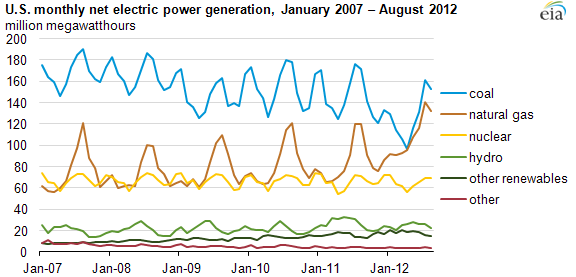
Electricity generation from coal and natural gas both increased with summer heat

Note: Data for 2011 and 2012 are preliminary. Chart includes generation from the electric power sector only, excluding commercial and industrial generators.
In August 2012, coal produced 39% of U.S. electricity, up from a low of 32% in April 2012, when the natural gas share of generation equaled that of coal. Increased demand for electric power in the summer months—to run air conditioners—created more room in the market, and generation from both fuels increased between April and July. The August coal share of generation is still notably lower than the 50% annual average over the 1990-2010 period.
Every year during the height of summer, natural gas-fired generation from peaking generators (used to meet the highest levels of electricity demand, and typically burning natural gas) increases to meet the demand for electricity, largely regardless of fuel prices. As demand for electric power moderates in the autumn months and the need for peaking generation moderates, total natural gas-fired generation decreases. Through the fall, if natural gas prices remain higher than in the spring, coal's share of generation may continue to increase.
The consumption of natural gas by electric power generators has been increasing each year since 2009 as lower natural gas prices allowed natural gas-fired generators to compete with coal-fired generators. Coal generation shares declined in some regions (such as the Southeast) in response to declining natural gas prices through 2010 and 2011, and then more broadly across the United States when gas prices dropped precipitously in the first half of 2012. Natural gas demand at electric power plants was particularly high this past spring and summer. However, natural gas prices have generally increased since April, the lowest point for natural gas prices during 2012.
The electric power industry dispatches power plants based on a number of factors, including relative fuel prices, which can vary across the United States. In the West, generators benefit from low-cost coal produced from large-scale mines in the Powder River Basin (PRB); in this region, the share of natural gas-fired power generation is most influenced by the availability of hydroelectric power, although increasing wind turbine generating capacity is also a factor. High levels of water runoff during 2011 led western generators to cut back on their use of natural gas.
In the eastern half of the United States, many power plants rely on bituminous coal mined in Appalachia and then transported by rail or barge to the power plant. Other plants use PRB coal transported by rail. Mining costs are much higher in this region than in the Powder River Basin (due in large part to less favorable geology and reserve depletion). The transportation charges can add significantly to the delivered fuel price to power plants. Historically, the average fuel cost of operating a combined-cycle natural gas generator exceeded that for a coal-fired generator.
Until 2010, substitution between the two fuels for electricity generation was not widespread in most U.S. regions. However, through 2010, 2011, and most dramatically in 2012, a shift in the historical spread between the average regional operating costs of combined-cycle natural gas fired and coal-fired generators led operators to run natural gas-fired combined-cycle plants for longer periods, while generation from coal-fired generators declined substantially.
During the first half of 2012, lower consumption of coal at electric power plants led to high coal stocks and a decrease in spot prices for eastern coal. Higher-than-normal coal stocks may continue to place downward pressure on coal prices. Also, high stocks could lead to additional coal burn if the size of coal stockpiles becomes a major concern. Utilities may also resell coal, even rerouting purchases before they are delivered to the plant. Coal is also being exported in growing volumes.
Tags: coal, electricity, generation, natural gas, prices